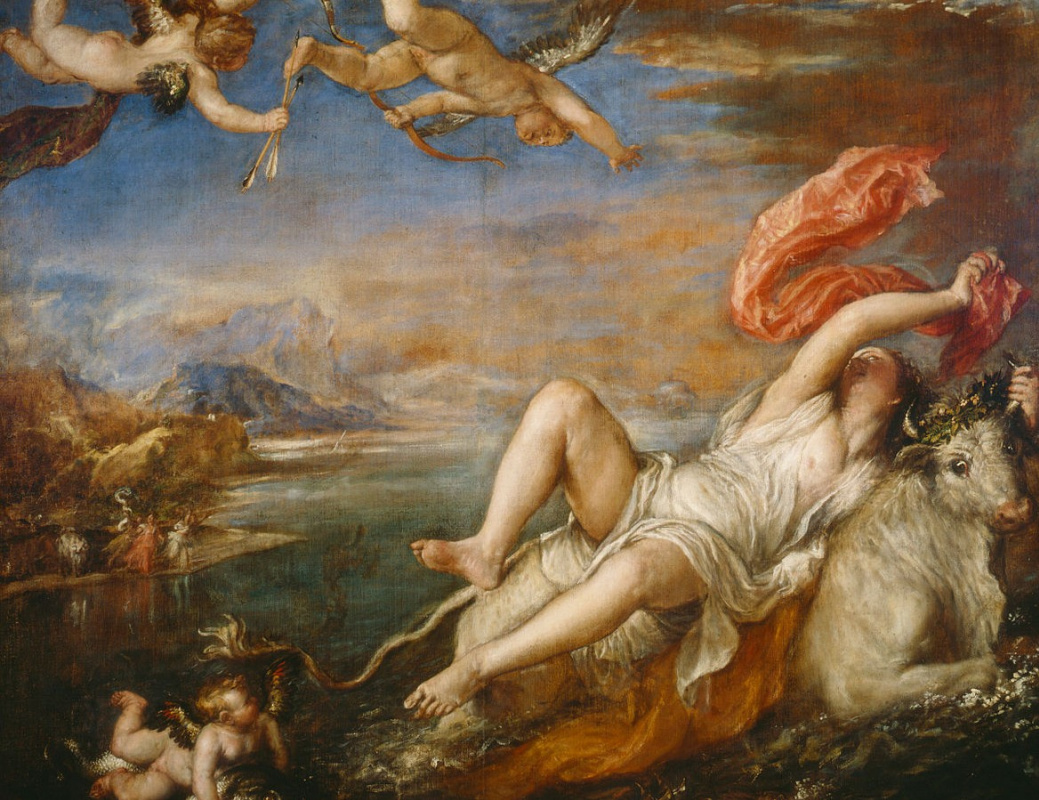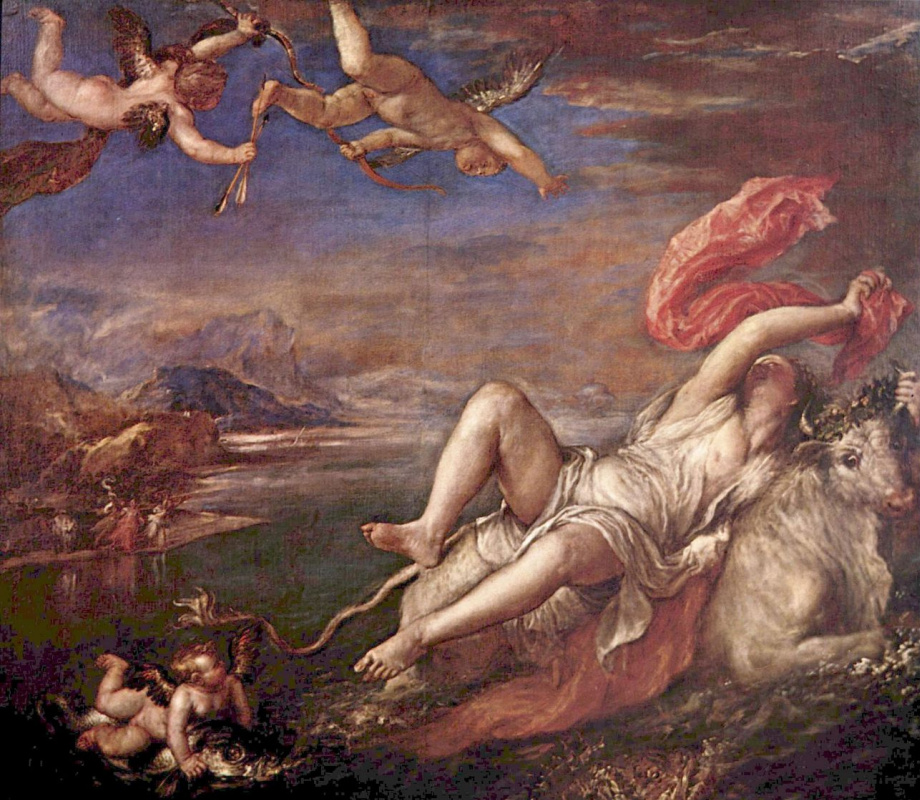log in
Enter site
Login to use Arthive functionality to the maximum
Abduction of Europe
Titian Vecelli • Painting, 1562, 178×205 cm
Description of the artwork «Abduction of Europe»
The idea of The Abduction of Europe by Titian in Venice in the 1560s was inspired by Ovid's poem Metamorphoses, a unique collection of ancient myths. Along with other paintings, the subject of which were plots from Greek mythology, "The Abduction of Europe" was created for the Spanish king Philip II. Later, the painting, along with two other works by Titian - “Diana and Callisto” and “Diana and Acteon” - was transmitted by the Spanish King Philip V to the Ambassador of France, Duke Gramont, who presented this gift to the court of Philip II, Duke of Orleans. The work remained in the Orleans collection until 1896. Bernard Branson, an American historian and art historian, acquired The Abduction of Europe from Earl Darnley on behalf of the famous American collector Isabella Stuart Gardner. The canvas is remarkably preserved; today it can be seen at the Isabella Stewart Gardner Museum in Boston, Massachusetts, USA.
The beautiful Europe was the only daughter of Agenor, who reigned in the rich Phoenician city of Sidon. Once she saw a dream in which two women fought for her. One of them was seen by Europe as the continent of Asia, and the second - as land beyond the sea. In the fight, Asia lost and lost Europe to a second woman. Waking up, Europe turned to the gods with prayers, asking them to turn away possible misfortune from her. After she called her friends and went with them for a walk on the seashore.
A beautiful girl liked Zeus, the main thing over the gods. Having decided to kidnap Europe, Zeus the Thunderer turned into a white bull and joined the herd grazing by the sea, where Europe with its companions was strolling at that time. The beauty of the white bull conquered the girl: she approached the creature with outstretched hand, and the bull remained calm. Europe began to play with a humble animal, decorated its horns with garlands of flowers, and then climbed onto its back. It was then that mischievous Zeus and took her to the sea. The girl clung in horror to the beautiful bull, who rushed with her towards the foamy waves.
Titian depicted in his picture Zeus rushing on the crest of a wave in the form of a bull; on his back, the beautiful Europe clings to the horn with one hand, and the second waved a red thin scarf, trying to attract the attention of the friends who remained on the shore. Satellites of Europe see how it is moving into the sea, but powerless to do anything. The dramatic component is the formidable spiky sea monster, which Titian placed in the foreground, symbolizes the hopelessness of what is happening: after all, Europe is more likely to remain on the back of the bull than to let the monster eat itself. Following the bull, cupid swims on the dolphin’s back, imitating the pose of Europe - perhaps mocking her plight. The diagonal composition chosen by the artist for this work gives the figures a sense of movement, which is echoed by a curving shore and an uneven mountain range.
According to the myth, Zeus moved Europe to the island of Crete. From this union, three sons were born: Radamanf, Sarpedon and Minos, who became king of the capital of Crete - Knossos, the cradle of the first European civilization. As a sign of Zeus's love for Europe, a constellation of the divine bull, Taurus, appeared in the sky.
The beautiful Europe was the only daughter of Agenor, who reigned in the rich Phoenician city of Sidon. Once she saw a dream in which two women fought for her. One of them was seen by Europe as the continent of Asia, and the second - as land beyond the sea. In the fight, Asia lost and lost Europe to a second woman. Waking up, Europe turned to the gods with prayers, asking them to turn away possible misfortune from her. After she called her friends and went with them for a walk on the seashore.
A beautiful girl liked Zeus, the main thing over the gods. Having decided to kidnap Europe, Zeus the Thunderer turned into a white bull and joined the herd grazing by the sea, where Europe with its companions was strolling at that time. The beauty of the white bull conquered the girl: she approached the creature with outstretched hand, and the bull remained calm. Europe began to play with a humble animal, decorated its horns with garlands of flowers, and then climbed onto its back. It was then that mischievous Zeus and took her to the sea. The girl clung in horror to the beautiful bull, who rushed with her towards the foamy waves.
Titian depicted in his picture Zeus rushing on the crest of a wave in the form of a bull; on his back, the beautiful Europe clings to the horn with one hand, and the second waved a red thin scarf, trying to attract the attention of the friends who remained on the shore. Satellites of Europe see how it is moving into the sea, but powerless to do anything. The dramatic component is the formidable spiky sea monster, which Titian placed in the foreground, symbolizes the hopelessness of what is happening: after all, Europe is more likely to remain on the back of the bull than to let the monster eat itself. Following the bull, cupid swims on the dolphin’s back, imitating the pose of Europe - perhaps mocking her plight. The diagonal composition chosen by the artist for this work gives the figures a sense of movement, which is echoed by a curving shore and an uneven mountain range.
According to the myth, Zeus moved Europe to the island of Crete. From this union, three sons were born: Radamanf, Sarpedon and Minos, who became king of the capital of Crete - Knossos, the cradle of the first European civilization. As a sign of Zeus's love for Europe, a constellation of the divine bull, Taurus, appeared in the sky.



